

| Cruise Region : Europe |
| Company : Croisi Europe |
| Ship : MS Rhone Princess |
| Journey Start : հնգ 30 հոկ 2025 |
| Journey End : երկ 03 նոյ 2025 |
| Count Nights : 4 nights |
| Day | Date | Port | Arrival | Departure |
|---|---|---|---|---|
| 1 | 30.10 հնգ | Լիոն / France | 18:00 | |
| 2 | 31.10 ուր | Լիոն / France | 05:00 | |
| 2 | 31.10 ուր | Ten-l'Ermitage / France | 13:00 | |
| 3 | 1.11 շբթ | Ten-l'Ermitage / France | 02:00 | |
| 3 | 1.11 շբթ | Երակային / Austria | 07:30 | 11:00 |
| 3 | 1.11 շբթ | Լիոն / France | 14:00 | 17:30 |
| 3 | 1.11 շբթ | Կոլլոնժ-օ-Մոն-դ’Օր / France | 19:15 | |
| 4 | 2.11 կիր | Կոլլոնժ-օ-Մոն-դ’Օր / France | 03:00 | |
| 4 | 2.11 կիր | Մեյսոն / France | 08:30 | 11:00 |
| 4 | 2.11 կիր | Բելվիլ / France | 13:30 | 14:15 |
| 4 | 2.11 կիր | Տրևու / France | 16:30 | 19:00 |
| 4 | 2.11 կիր | Լիոն / France | 22:30 |
All inclusive on board:
All meals included - DRINKS INCLUDED with meals and at the bar
Refined French cuisine - Gala dinner and evening - Welcome cocktail
Free Wi-Fi onboard
Headsets are included for excursions
Official welcome from the captain and crew
Onboard activities
Travel assistance and repatriation insurance
All port fees included
Additional expenses:
Airfare and transfers to/from the departure and arrival ports
Personal expenses (e.g., souvenirs, extra drinks beyond those included)
Tips for crew and guides (recommended) from €9 per day per guest
Medical insurance (optional, at your own discretion)
Excursions and activities not included in the program
Additional onboard services (spa, massage, laundry, etc.)
PAYMENT AND BOOKING CONDITIONS:
A deposit 30 % is due within 4 days after confirmation if you pay credit card, bank transfer, or personal check. If you pay by credit card, you must sign an authorization form. If paying by wire transfer, the transfer must be received within 8 days after confirmation. Final payment is due at least 90 days prior to departure. Vouchers will be sent by email at 30 days prior to departure and only when full payment has been made. You are considered confirmed when we receive your deposit of 30 % of the price of the cruise, or, if you are confirmed within 90 days before departure, you are confirmed when we receive your full payment. Failure to pay the balance by the 90-day deadline is a default that entitles us to cancel your agreement and retain your deposit if you do not pay within eight days after notice of nonpayment.
CANCELLATION:
1) TRAVELLER’S RIGHT OF CANCELLATION
The traveller may cancel the contract at any time prior to the start of the trip or stay, subject to the payment of appropriate cancellation fees or, where applicable, standard cancellation fees charged by the organiser or retailer, in accordance with Article L. 211-14 I of the French Tourism Code.
2) CANCELLATION COSTS
In the event of cancellation by the customer, and in accordance with Article L 211-14 of the French Tourism Code, the sums paid will be reimbursed minus the cancellation fees per person specified below, depending on the date of cancellation in relation to the departure date, and the non-refundable costs of insurance, reservation fees and visa fees, as well as all other insurance and cancellation fees required by our suppliers. If one of the passengers in a double room or cabin cancels his/her reservation, the remaining passenger will have to pay the double room or cabin supplement for individual use. All cancellations must be sent to the seller by registered mail with acknowledgment of receipt..
Cost of cancelling CroisiEurope river cruises:
• More than 90 days before date of departure: 150 €, not including VAT, in administration fees will be charged per person (fees for themed-weekend and Christmas-market cruises are listed after)
• From 90 to 60 days: 20 % of total amount of cruise package
• From 59 to 30 days: 50 % of total amount of cruise package
• From 29 to 19 days: 60 % of total amount of cruise package
• From 18 to 9 days: 75 % of total amount of cruise package
• 8 days or less before departure: 100 % of total amount of cruise package
For CroisiEurope themed-weekend and Christmas-market river cruises, a cancellation fee of 50 €, not including VAT, will be charged per person at more than 90 days before departure. The fee schedule listed above remains unchanged for these cruises.
Cost of cancelling CroisiEurope seafaring cruises:
• More than 90 days before date of departure: 300 €, not including VAT, in administration fees will be charged per person
• From 90 to 60 days: 40 % of total amount of cruise package
• From 59 to 30 days: 60 % of total amount of cruise package
• From 29 to 9 days: 75 % of total amount of cruise package
• 8 days or less before departure: 100 % of total amount of cruise package
Cancellation terms and conditions above, the cancellation fees for CroisiEurope “New Year’s Eve” river and seafaring cruises are as follows:
• More than 90 days before date of departure: 300 €, not including
VAT, in administration fees will be charged per person
• From 90 to 60 days: 40 % of total amount of cruise package
• From 59 to 30 days: 60 % of total amount of cruise package
• From 29 to 20 days: 75 % of total amount of cruise package
• 19 days or less before departure: 100 % of total amount of cruise package
Cancellation fees for the cruises on the Mekong, Ganges, Nile and in Southern Africa:
• More than 90 days before date of departure: 300 €, not including VAT, in administration fees will be charged per person
• From 90 to 61 days: 35 % of total amount of cruise package
• From 60 to 31 days: 50 % of total amount of cruise package
• From 30 to 20 days: 70 % of total amount of cruise package
• From 19 to 9 days: 80 % of total amount of cruise package
• 8 days or less before departure: 100 % of total amount of cruise package
By accepting these general terms and conditions of sale, the traveller expressly acknowledges that he/she has been previously informed and agrees to the cancellation fees in the manner set out above.
IMPORTANT: All packages including air transport are subject to the general and specific cancellation conditions of the designated airline companies. In the event of cancellation by one or more passengers, the following cancellation conditions shall be applied:
• River, maritime and coastal services: pursuant to the general terms and conditions of CroisiEurope.
• Air transport: terms and conditions of the designated airline company, available on the web sites of the respective airlines or from our booking departments on request.
In addition, the amount of cancellation fees relating to land-based services (hotel, for example) will correspond to the amount of actual fees invoiced by the partner to CroisiEurope.
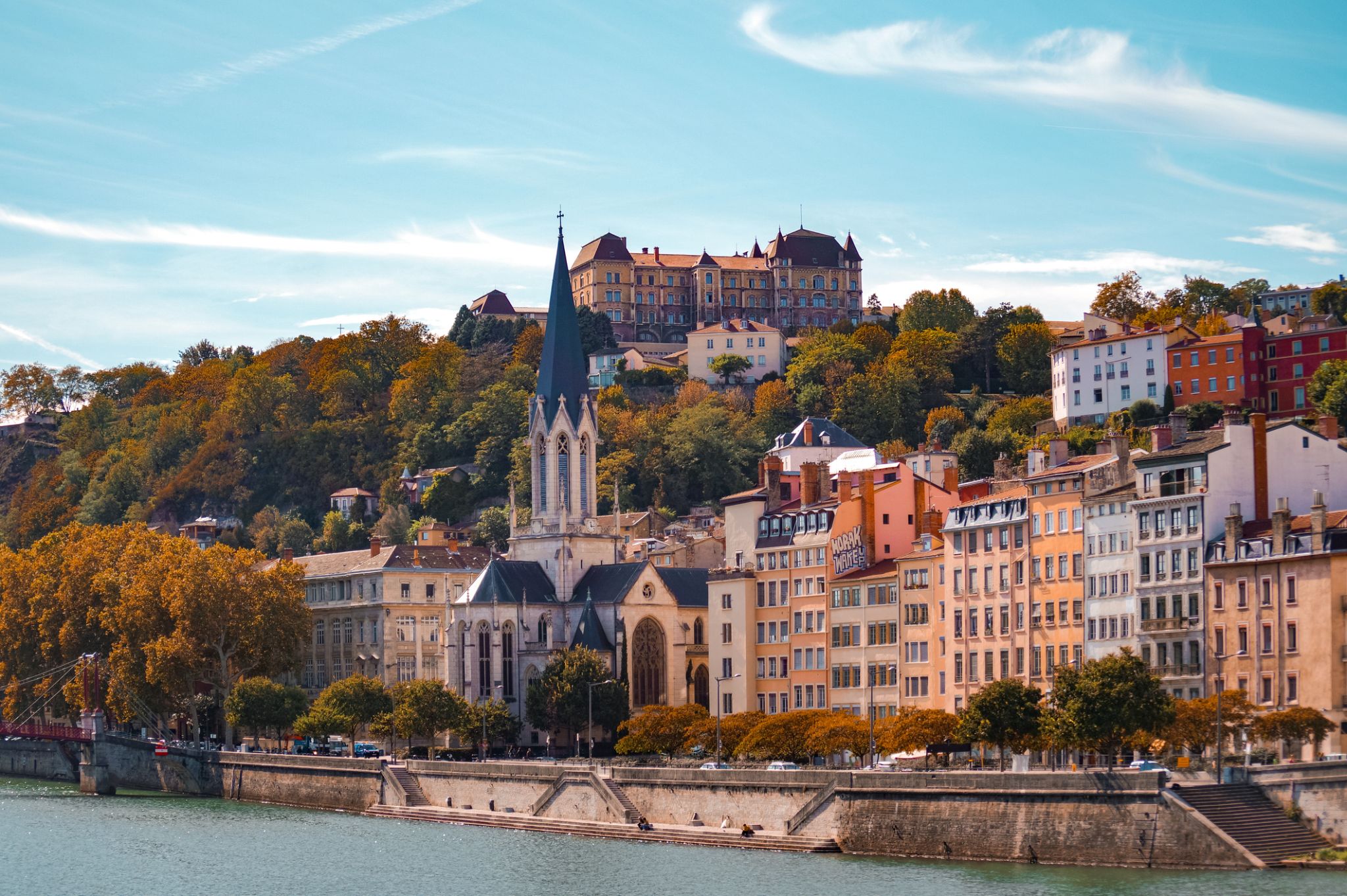
Lyon is the third-largest city and second-largest urban area of France. It is located in the country's east-central part at the confluence of the rivers Rhône and Saône,about 470 km (292 mi) south from Paris, 320 km (199 mi) north from Marseille and 56 km (35 mi) northeast from Saint-Étienne. Inhabitants of the city are called Lyonnais.
Lyon had a population of 513,275 in 2015. It is the capital of the Metropolis of Lyon and the region of Auvergne-Rhône-Alpes. The Lyon metropolitan area had a population of 2,265,375 in 2014, the second-largest urban area in France. The city is known for its cuisine and gastronomy, and historical and architectural landmarks; part of it is a registered as a UNESCO World Heritage site. Lyon was historically an important area for the production and weaving of silk. Lyon played a significant role in the history of cinema: it is where Auguste and Louis Lumièreinvented the cinematograph. It is also known for its light festival, the Fête des Lumières, which begins every 8 December and lasts for four days, earning Lyon the title of Capital of Lights.
Economically, Lyon is a major centre for banking, as well as for the chemical, pharmaceutical, and biotech industries. The city contains a significant software industry with a particular focus on video games, and in recent years has fostered a growing local start-up sector. Lyon hosts the international headquarters of Interpol, the International Agency for Research on Cancer and Euronews. It was ranked 19th globally and second in France for innovation in 2014. It ranked second in France and 39th globally in Mercer's 2015 liveability rankings.

Lyon is the third-largest city and second-largest urban area of France. It is located in the country's east-central part at the confluence of the rivers Rhône and Saône,about 470 km (292 mi) south from Paris, 320 km (199 mi) north from Marseille and 56 km (35 mi) northeast from Saint-Étienne. Inhabitants of the city are called Lyonnais.
Lyon had a population of 513,275 in 2015. It is the capital of the Metropolis of Lyon and the region of Auvergne-Rhône-Alpes. The Lyon metropolitan area had a population of 2,265,375 in 2014, the second-largest urban area in France. The city is known for its cuisine and gastronomy, and historical and architectural landmarks; part of it is a registered as a UNESCO World Heritage site. Lyon was historically an important area for the production and weaving of silk. Lyon played a significant role in the history of cinema: it is where Auguste and Louis Lumièreinvented the cinematograph. It is also known for its light festival, the Fête des Lumières, which begins every 8 December and lasts for four days, earning Lyon the title of Capital of Lights.
Economically, Lyon is a major centre for banking, as well as for the chemical, pharmaceutical, and biotech industries. The city contains a significant software industry with a particular focus on video games, and in recent years has fostered a growing local start-up sector. Lyon hosts the international headquarters of Interpol, the International Agency for Research on Cancer and Euronews. It was ranked 19th globally and second in France for innovation in 2014. It ranked second in France and 39th globally in Mercer's 2015 liveability rankings.
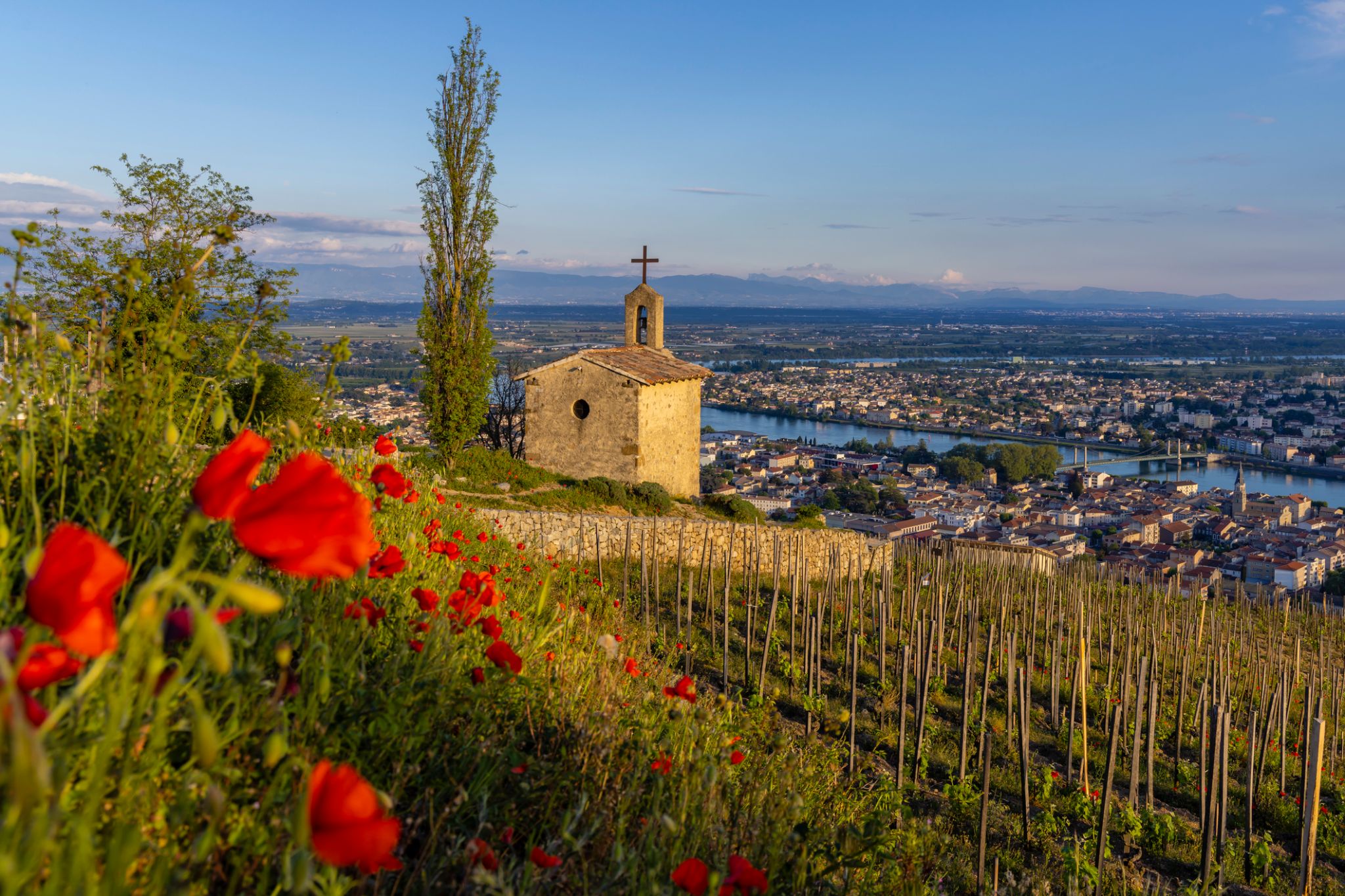
Tain-l'Hermitage is a commune in the Drôme department in southeastern France.
It is located on the left bank of the Rhône River, opposite Tournon-sur-Rhône, which is located in Ardèche. The view from the vine-covered hill above the town has attracted many tourists, including Thomas Jefferson.
A notable wine producing commune, wines include Hermitage AOC and Crozes-Hermitage AOC, Cornas AOC. The red wines are produced from Syrah, and the whites from Marsanne and/or Roussanne. Tain-l'Hermitage is home to a large number of wineries, including Maison M. Chapoutier, Caves de Tain and Paul Jaboulet Âiné, as well as many smaller domaines.
In 1818 the commune was the home of French wine négociant Calvet, founded by Jean-Marie Calvet. Shortly after, it expanded to Bordeaux, establishing itself in the city proper and building a château in the Médoc in 1870.

Tain-l'Hermitage is a commune in the Drôme department in southeastern France.
It is located on the left bank of the Rhône River, opposite Tournon-sur-Rhône, which is located in Ardèche. The view from the vine-covered hill above the town has attracted many tourists, including Thomas Jefferson.
A notable wine producing commune, wines include Hermitage AOC and Crozes-Hermitage AOC, Cornas AOC. The red wines are produced from Syrah, and the whites from Marsanne and/or Roussanne. Tain-l'Hermitage is home to a large number of wineries, including Maison M. Chapoutier, Caves de Tain and Paul Jaboulet Âiné, as well as many smaller domaines.
In 1818 the commune was the home of French wine négociant Calvet, founded by Jean-Marie Calvet. Shortly after, it expanded to Bordeaux, establishing itself in the city proper and building a château in the Médoc in 1870.
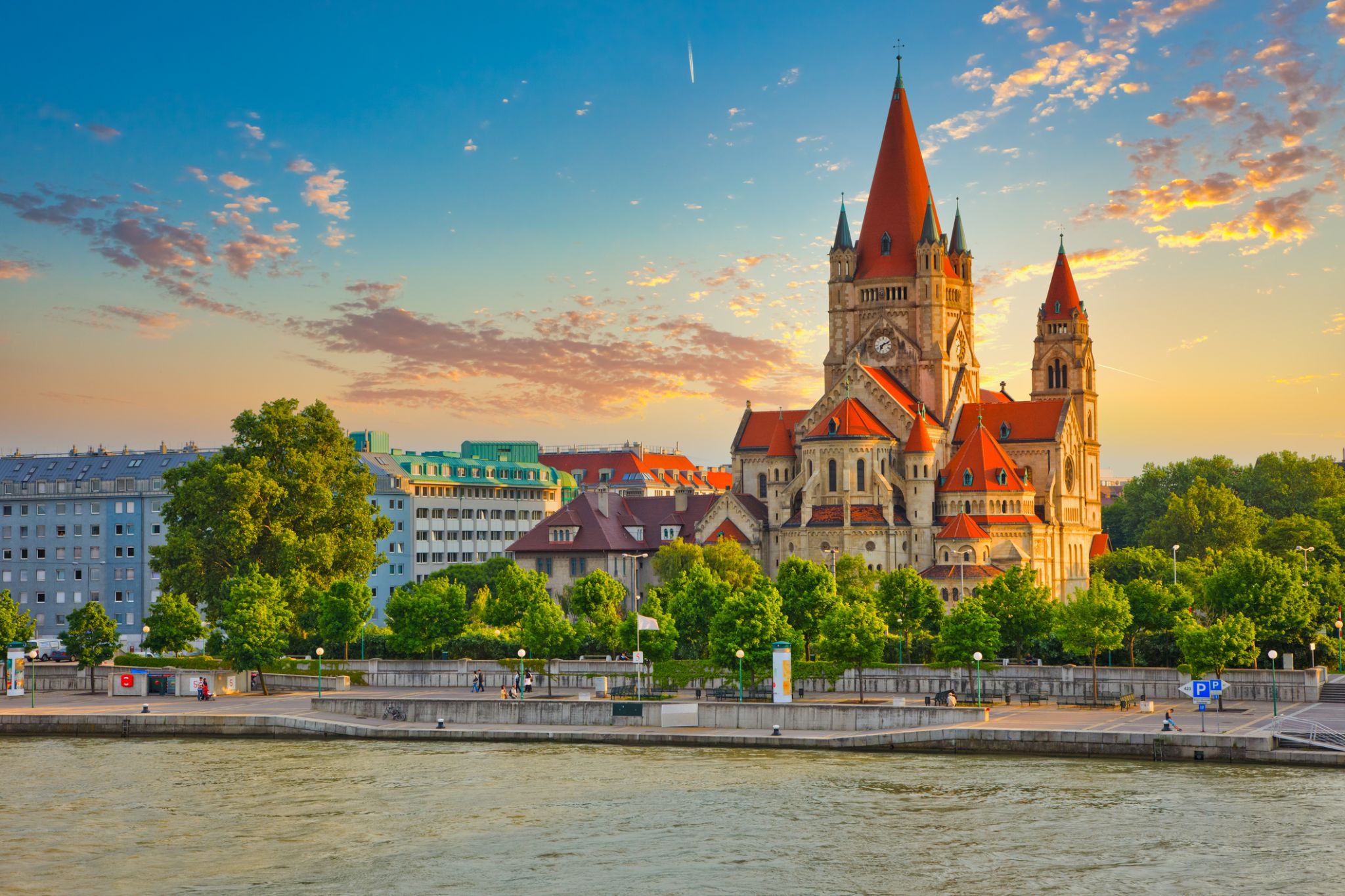
Vienna is the federal capital and largest city of Austria, and one of the nine states of Austria. Vienna is Austria's primate city, with a population of about 1.9 million (2.6 million within the metropolitan area, nearly one third of Austria's population), and its cultural, economic, and political centre. It is the 7th-largest city by population within city limits in the European Union. Until the beginning of the 20th century, it was the largest German-speaking city in the world, and before the splitting of the Austro-Hungarian Empire in World War I, the city had 2 million inhabitants. Today, it has the second largest number of German speakers after Berlin.Vienna is host to many major international organizations, including the United Nations and OPEC. The city is located in the eastern part of Austria and is close to the borders of the Czech Republic, Slovakia, and Hungary. These regions work together in a European Centrope border region. Along with nearby Bratislava, Vienna forms a metropolitan region with 3 million inhabitants. In 2001, the city centre was designated a UNESCO World Heritage Site. In July 2017 it was moved to the list of World Heritage in Danger.
Apart from being regarded as the City of Music[ because of its musical legacy, Vienna is also said to be "The City of Dreams" because it was home to the world's first psychoanalyst – Sigmund Freud. The city's roots lie in early Celticand Roman settlements that transformed into a Medieval and Baroque city, and then the capital of the Austro-Hungarian Empire. It is well known for having played an essential role as a leading European music centre, from the great age of Viennese Classicism through the early part of the 20th century. The historic centre of Vienna is rich in architectural ensembles, including Baroque castles and gardens, and the late-19th-century Ringstraße lined with grand buildings, monuments and parks.
Vienna is known for its high quality of life. In a 2005 study of 127 world cities, the Economist Intelligence Unit ranked the city first (in a tie with Vancouver and San Francisco) for the world's most liveable cities. Between 2011 and 2015, Vienna was ranked second, behind Melbourne. In 2018, it replaced Melbourne as the number one spot. For eight consecutive years (2009–2016), the human-resource-consulting firm Mercer ranked Vienna first in its annual "Quality of Living" survey of hundreds of cities around the world, a title the city still held in 2016. Monocle's 2015 "Quality of Life Survey" ranked Vienna second on a list of the top 25 cities in the world "to make a base within."
The UN-Habitat classified Vienna as the most prosperous city in the world in 2012/2013. The city was ranked 1st globally for its culture of innovation in 2007 and 2008, and sixth globally (out of 256 cities) in the 2014 Innovation Cities Index, which analyzed 162 indicators in covering three areas: culture, infrastructure, and markets. Vienna regularly hosts urban planning conferences and is often used as a case study by urban planners.
Between 2005 and 2010, Vienna was the world's number-one destination for international congresses and conventions. It attracts over 6.8 million tourists a year.

Lyon is the third-largest city and second-largest urban area of France. It is located in the country's east-central part at the confluence of the rivers Rhône and Saône,about 470 km (292 mi) south from Paris, 320 km (199 mi) north from Marseille and 56 km (35 mi) northeast from Saint-Étienne. Inhabitants of the city are called Lyonnais.
Lyon had a population of 513,275 in 2015. It is the capital of the Metropolis of Lyon and the region of Auvergne-Rhône-Alpes. The Lyon metropolitan area had a population of 2,265,375 in 2014, the second-largest urban area in France. The city is known for its cuisine and gastronomy, and historical and architectural landmarks; part of it is a registered as a UNESCO World Heritage site. Lyon was historically an important area for the production and weaving of silk. Lyon played a significant role in the history of cinema: it is where Auguste and Louis Lumièreinvented the cinematograph. It is also known for its light festival, the Fête des Lumières, which begins every 8 December and lasts for four days, earning Lyon the title of Capital of Lights.
Economically, Lyon is a major centre for banking, as well as for the chemical, pharmaceutical, and biotech industries. The city contains a significant software industry with a particular focus on video games, and in recent years has fostered a growing local start-up sector. Lyon hosts the international headquarters of Interpol, the International Agency for Research on Cancer and Euronews. It was ranked 19th globally and second in France for innovation in 2014. It ranked second in France and 39th globally in Mercer's 2015 liveability rankings.

Լիոնից հյուսիս՝ կանաչ բլուրների ու խաղողի այգիների մեջ թաքնված է Կոլլոնժ-օ-Մոն-դ’Օր գյուղը, որտեղ ֆրանսիական նրբագեղությունը միահյուսվում է գաստրոնոմիական ժառանգությանը։ Այստեղ է գտնվում աշխարհահռչակ խոհարար Պոլ Բոկյուզի ռեստորանը՝ 20-րդ դարի ամենաազդեցիկ խոհարարներից մեկի, որն այսօր էլ գրավում է աշխարհի գուրմաններին։
Թեթև զբոսանք Սոն գետի ափով կամ գյուղի նեղ փողոցներով՝ հին քարե տներով, լցնում է հանգստության և ջերմության զգացումով։ Collonge-au-Mont-d'Or-ը հմայում է իր բնության ներդաշնակությամբ, իսկ Լիոնին մոտ լինելը այն դարձնում է հիանալի ուղղություն կարճատև հանգստի կամ գաստրոնոմիական հանգստյան օրերի համար։

Լիոնից հյուսիս՝ կանաչ բլուրների ու խաղողի այգիների մեջ թաքնված է Կոլլոնժ-օ-Մոն-դ’Օր գյուղը, որտեղ ֆրանսիական նրբագեղությունը միահյուսվում է գաստրոնոմիական ժառանգությանը։ Այստեղ է գտնվում աշխարհահռչակ խոհարար Պոլ Բոկյուզի ռեստորանը՝ 20-րդ դարի ամենաազդեցիկ խոհարարներից մեկի, որն այսօր էլ գրավում է աշխարհի գուրմաններին։
Թեթև զբոսանք Սոն գետի ափով կամ գյուղի նեղ փողոցներով՝ հին քարե տներով, լցնում է հանգստության և ջերմության զգացումով։ Collonge-au-Mont-d'Or-ը հմայում է իր բնության ներդաշնակությամբ, իսկ Լիոնին մոտ լինելը այն դարձնում է հիանալի ուղղություն կարճատև հանգստի կամ գաստրոնոմիական հանգստյան օրերի համար։

Սոն գետի ափերին հարմարավետ տեղակայված Մակոն կախարդում է Բուրգունդիայի հարավի մթնոլորտով։ Այս ֆրանսիական քաղաքը միավորում է նուրբ ճարտարապետությունը, հին գինեգործության ավանդույթները և հանգիստ կենսակերպը։ Մակոն հայտնի է որպես բանաստեղծ Ալֆոնս դե Լամարտինի ծննդավայրը, ինչպես նաև Մակոննեի գինու շրջանի կենտրոնը, որը հռչակված է հատկապես շարդոնե տեսակի շնորհիվ։
Քայլելով հին քաղաքով՝ կարելի է տեսնել ծաղկաշատ պատշգամբներ, հարմարավետ սրճարաններ և պատմական շինություններ, ինչպիսիք են Սեն Պիեռ եկեղեցին և 15-րդ դարի փայտե տունը։ Բնության և խոհանոցի սիրահարները կարող են ուսումնասիրել գինու ճանապարհները կամ վայելել Սեն Լորան կամրջից բացվող տեսարանները։ Մակոն իդեալական վայր է՝ առանց մեծ քաղաքների աղմուկի ֆրանսիական հմայքը զգալու համար։
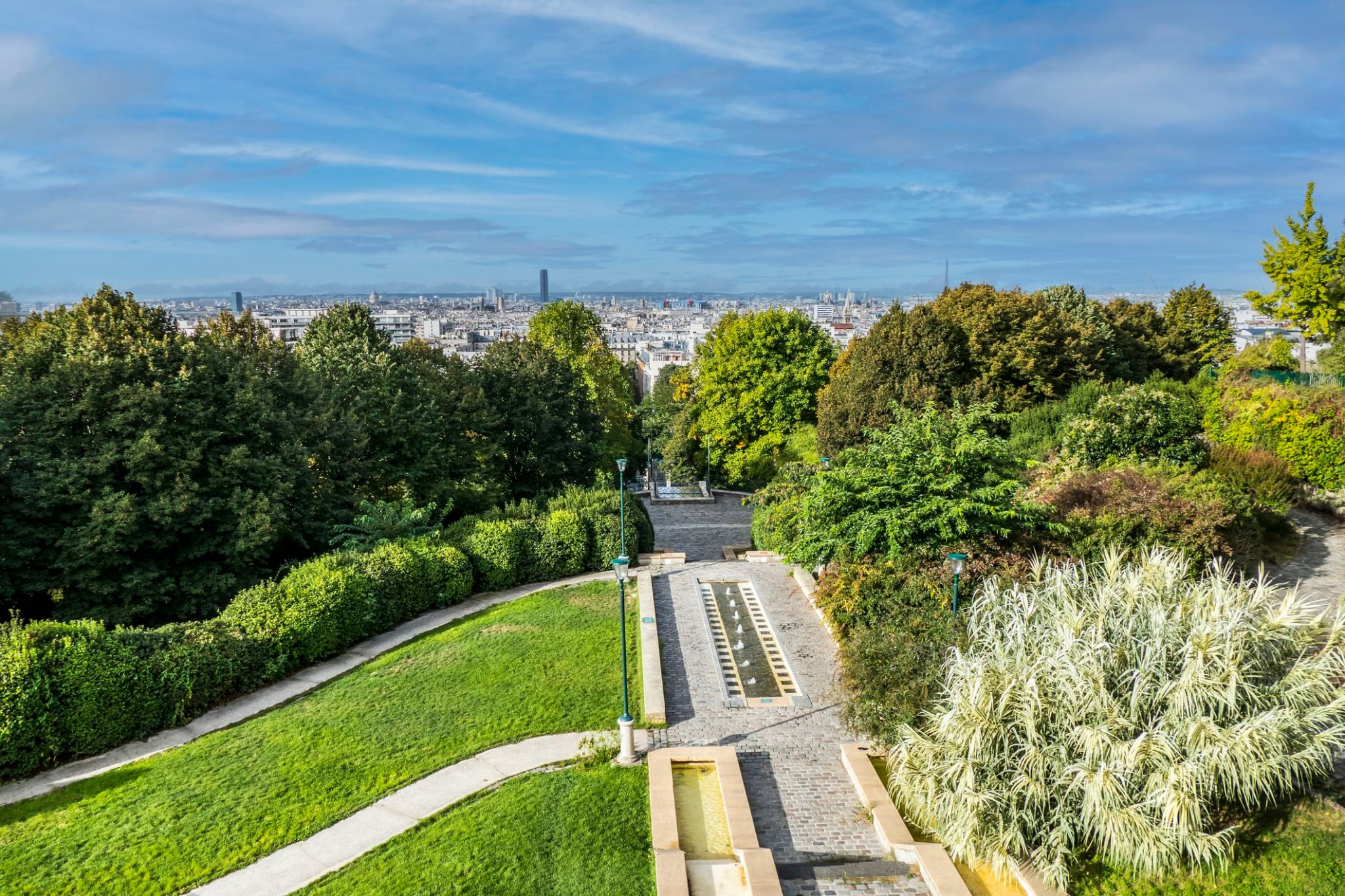
Բելվիլը իր հարստացած մշակութային ու ավանդույթների խառնուրդով տուրիստներին առաջարկում է իսկական պարիրվյան ոգին ապրելու եզակի հնարավորություն: Այս շրջանը գրավում է իր մթնոլորտով, որտեղ հին փողոցները միաձուլվում են ժամանակակից սրճարանների ու շուկաների հետ, իսկ բազմաթիվ ռեստորանները ներկայացնում են աշխարհի տարբեր անկյուններից ճաշատեսակներ: Բելվիլ պարքի կանաչ տարածքում զբոսանքները հնարավորություն են տալիս հանգստանալու քաղաքի աղմուկից, վայելելով բնությունն ու գեղեցիկ տեսարանները դեպի Փարիզ:
Բելվիլը նաև մշակութային կյանքի կենտրոն է, որտեղ արվեստն ու ստեղծագործությունը միաձուլվում են պատմության հետ: Ճանապարհային նկարիչները, մշակութային միջոցառումները և հետաքրքիր ցուցահանդեսները ընձեռում են շրջանին յուրահատուկ մթնոլորտ, որն արտացոլում է քաղաքի բազմազանությունն ու էներգիան: Սա այն վայրն է, որտեղ տուրիստները կարող են ապրել իսկական Փարիզի մթնոլորտում՝ հեռու սովորական զբոսաշրջիկային երթուղիներից:
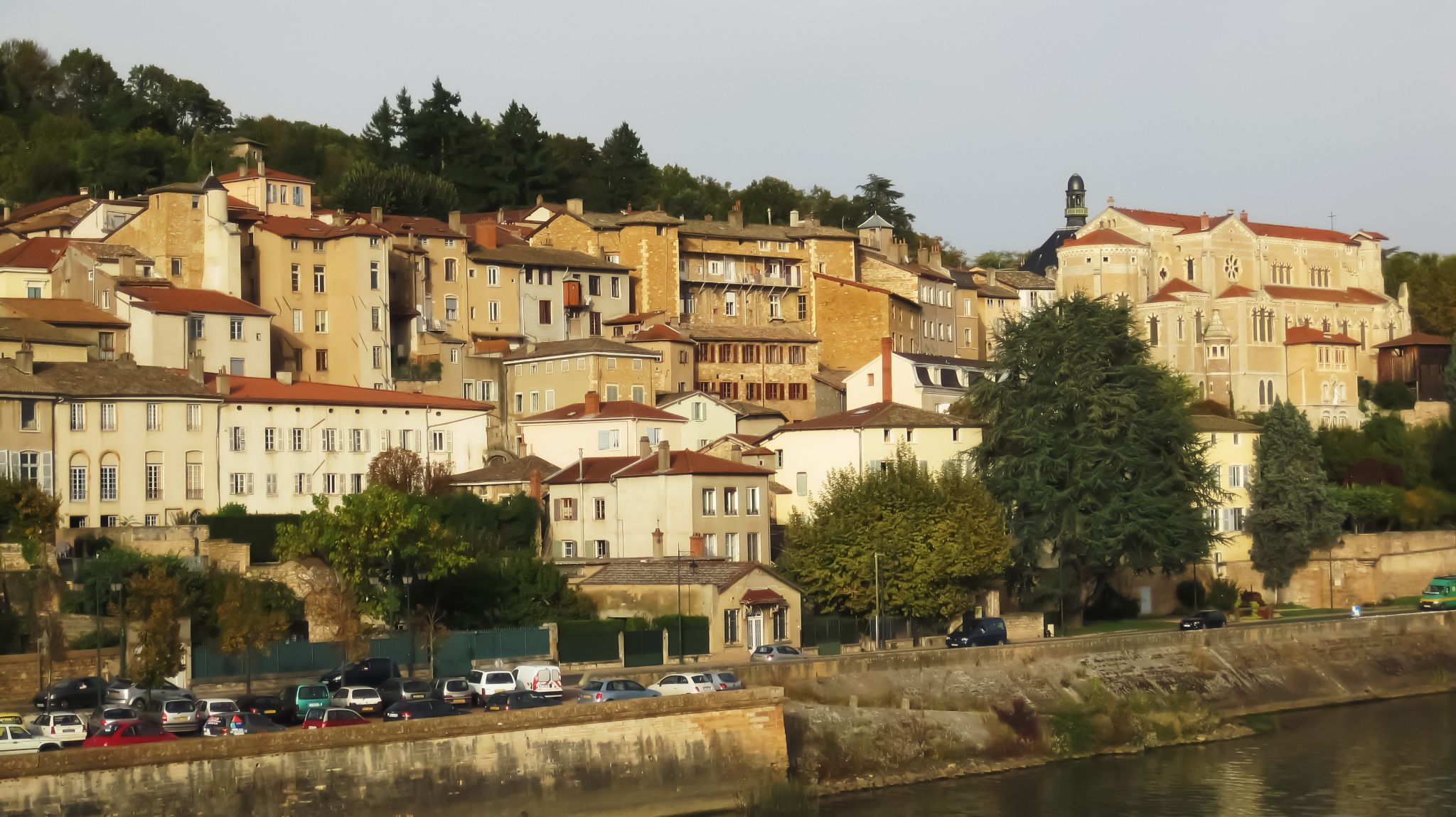
Trévoux is a commune in the Ain department in eastern France. The inhabitants are known as Trévoltiens.
It is a suburb of Lyon, built on the steeply sloping left bank of the river Saône.
In AD 943, the treaty of Verdun divided up the empire of Charlemagne. The river Saône became the frontier between France and the Empire. It is thanks to this border location that Trévoux gained its particular political status.
From the 13th century, the Trévoux river toll became important, and the town built a castle and walls.
On the 30th of June 1417, the local baron issued a decree allowing the local Jewish population to continue to study the Talmud, contrary to the decision taken in Chambéry in January 1417 as a result of which Jewish books had been seized and burned.
In 1523, the French king François the 1st confiscated the Dombes region and founded a parliament for the region in Lyon.
At the end of the 17th century, two important sovereign princes, Anne-Marie Louise of Orléans, Duchess of Montpensier known as "la Grande Mademoiselle", and her successor Louis-Auguste of Bourbon, duke of Maine, raised two monuments which are still notable in the landscape - the Montpensier hospital and the Palace of the Dombes Parliament.
In 1560, the Dombes region fell to the Bourbons. The town became rich as the capital of Dombes principality and seat of its parliament from 1697 to 1771. The town is also known at this time for a dictionary, printed there from 1704 to 1771 by the Jesuits.
In 1762, the principality of the Dombes was definitively absorbed into France.
The town was a sub-prefecture of Ain until 1926.
From the end of the 19th century until the 1950s, Trévoux was the global capital of the manufacture of synthetic diamonds.

Lyon is the third-largest city and second-largest urban area of France. It is located in the country's east-central part at the confluence of the rivers Rhône and Saône,about 470 km (292 mi) south from Paris, 320 km (199 mi) north from Marseille and 56 km (35 mi) northeast from Saint-Étienne. Inhabitants of the city are called Lyonnais.
Lyon had a population of 513,275 in 2015. It is the capital of the Metropolis of Lyon and the region of Auvergne-Rhône-Alpes. The Lyon metropolitan area had a population of 2,265,375 in 2014, the second-largest urban area in France. The city is known for its cuisine and gastronomy, and historical and architectural landmarks; part of it is a registered as a UNESCO World Heritage site. Lyon was historically an important area for the production and weaving of silk. Lyon played a significant role in the history of cinema: it is where Auguste and Louis Lumièreinvented the cinematograph. It is also known for its light festival, the Fête des Lumières, which begins every 8 December and lasts for four days, earning Lyon the title of Capital of Lights.
Economically, Lyon is a major centre for banking, as well as for the chemical, pharmaceutical, and biotech industries. The city contains a significant software industry with a particular focus on video games, and in recent years has fostered a growing local start-up sector. Lyon hosts the international headquarters of Interpol, the International Agency for Research on Cancer and Euronews. It was ranked 19th globally and second in France for innovation in 2014. It ranked second in France and 39th globally in Mercer's 2015 liveability rankings.